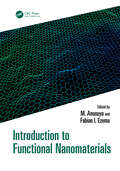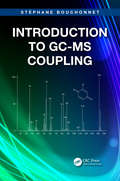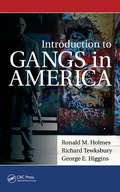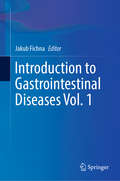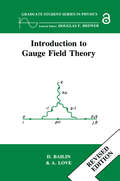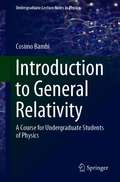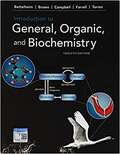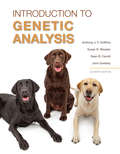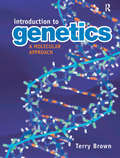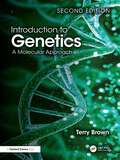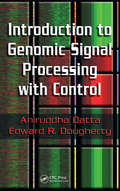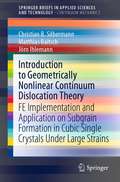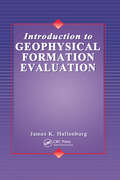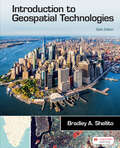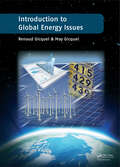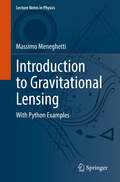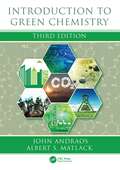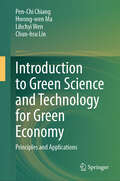- Table View
- List View
Introduction to Fuel Cells: Electrochemistry and Materials
by San Ping Jiang Qingfeng LiThis textbook covers essential electrochemistry and materials science content and provides an extensive collection of examples in order to bridge the gap between engineering students’ basic knowledge and the concrete skills they need to handle practical problems in fuel cells. The book starts with an introduction to the basic thermodynamics and electrochemistry principles and techniques in fuel cells. It subsequently discusses fuel cell operation principles, electrocatalysts, electrode materials, cell and system configuration and technologies in low-temperature fuel cells such as alkaline fuel cells and proton exchange membrane fuel cells, and in high-temperature fuel cells including solid oxide and molten carbonate fuel cells. Other energy conversion and storage technologies such as supercapacitors, batteries and electrolysis are also covered. A special chapter on laboratory experiments with fuel cells is also included, which can be conducted in conjunction with classroom teaching. Each chapter includes problems and exercises.The book provides students with an engineering background essential information on the basic thermodynamics, electrochemistry and materials of fuel cells, the most efficient and environmentally friend energy conversion technologies, all in a single book.
Introduction to Functional Nanomaterials
by Fabian I. Ezema M. AnusuyaThis book provides a comprehensive review of nanomaterials, including essential foundational examples of nanosensors, smart nanomaterials, nanopolymers, and nanotubes. Chapters cover their synthesis and characteristics, production methods, and applications, with specific sections exploring nanoelectronics and electro-optic nanotechnology, nanostructures, and nanodevices. This book is a valuable resource for interdisciplinary researchers who want to learn more about the synthesis of nanomaterials and how they are used in different types of energy storage devices, including supercapacitors, batteries, fuel cells solar cells in addition to electrical, chemical, and biomedical engineering.Key Features: Comprehensive overview of how nanomaterials can be utilised in a variety of interdisciplinary applications Explores the fundamental theories, alongside their electrochemical mechanisms and computation Discusses recent developments in electrode designing based on nanomaterials, separators, and the fabrication of advanced devices and their performances
Introduction to Fungi
by John Webster Roland WeberThis new edition of the universally acclaimed and widely-used textbook on fungal biology has been completely re-written, drawing directly on the authors' research and teaching experience. The text takes account of the rapid and exciting progress that has been made in the taxonomy, cell and molecular biology, biochemistry, pathology and ecology of the fungi. Features of taxonomic relevance are integrated with natural functions, including their relevance to human affairs. Special emphasis is placed on the biology and control of human and plant pathogens, providing a vital link between fundamental and applied mycology. The book is richly illustrated throughout with specially prepared drawings and photographs, based on living material. Illustrated life-cycles are provided, and technical terms are clearly explained. Extensive reference is made to recent literature and developments, and the emphasis throughout is on whole-organism biology from an integrated, multidisciplinary perspective.
Introduction to GC-MS Coupling
by Stephane BouchonnetAlthough GC-MS (gas chromatography-mass spectrometry) finds applications in fields as diverse as the food processing industry, medicine, pharmacology, and environmental analysis, the few works that are dedicated to this use of mass spectrometry are generally highly complex and theoretical. Emphasizing the practical aspects of GC-MS, without neglect
Introduction to Galaxy Formation and Evolution: From Primordial Gas to Present-Day Galaxies
by Andrea Cimatti Filippo Fraternali Carlo NipotiPresent-day elliptical, spiral and irregular galaxies are large systems made of stars, gas and dark matter. Their properties result from a variety of physical processes that have occurred during the nearly fourteen billion years since the Big Bang. This comprehensive textbook, which bridges the gap between introductory and specialized texts, explains the key physical processes of galaxy formation, from the cosmological recombination of primordial gas to the evolution of the different galaxies that we observe in the Universe today. In a logical sequence, the book introduces cosmology, illustrates the properties of galaxies in the present-day Universe, then explains the physical processes behind galaxy formation in the cosmological context, taking into account the most recent developments in this field. The text ends on how to find distant galaxies with multi-wavelength observations, and how to extract the physical and evolutionary properties based on imaging and spectroscopic data.
Introduction to Gangs in America
by Richard Tewksbury Ronald M. Holmes George HigginsGangs have long been a social and criminal threat to society. Introduction to Gangs in America explains how gangs are addressed as a criminal justice and public policy problem, providing a student-friendly, easily accessible, concise overview of the role, place, structure, and activities of gangs in American society. The book describes what gangs a
Introduction to Gastrointestinal Diseases Vol. 1
by Jakub FichnaOur own experience shows that there is no simple, yet of good scientific and clinical quality guide for practitioners and patients on gastrointestinal diseases. In the proposed book we will cover a vast area in the field, from GI tract physiology to disease diagnosis and treatment, in a comprehensive and approachable manner. The guide will not replace online resources (often used by patients) or specialized editions addressing experienced medical doctors, but rather fill the gap between those two. Our aim is to design this book so that it appeals to a wider audience; yet – if needed – encourages to explore the field further.
Introduction to Gauge Field Theory Revised Edition (Graduate Student Series In Physics Ser.)
by David Bailin Alexander LoveIntroduction to Gauge Field Theory provides comprehensive coverage of modern relativistic quantum field theory, emphasizing the details of actual calculations rather than the phenomenology of the applications. Forming a foundation in the subject, the book assumes knowledge of relativistic quantum mechanics, but not of quantum field theory. The book
Introduction to General Relativity: A Course for Undergraduate Students of Physics (Undergraduate Lecture Notes in Physics)
by Cosimo BambiFollowing the approach of Lev Landau and Evgenii Lifshitz, this book introduces the theory of special and general relativity with the Lagrangian formalism and the principle of least action. This method allows the complete theory to be constructed starting from a small number of assumptions, and is the most natural approach in modern theoretical physics. The book begins by reviewing Newtonian mechanics and Newtonian gravity with the Lagrangian formalism and the principle of least action, and then moves to special and general relativity. Most calculations are presented step by step, as is done on the board in class. The book covers recent advances in gravitational wave astronomy and provides a general overview of current lines of research in gravity. It also includes numerous examples and problems in each chapter.
Introduction to General, Organic and Biological Chemistry
by Charles Solomon Susan Sally Rutkowsky BortizIntroduction to General, Organic, and Biological Chemistry
Introduction to General, Organic, and Biochemistry: Twelfth Edition
by Frederick A. Bettelheim William H. Brown Mary K. Campbell Shawn O. Farrell Omar J. Torres Sara MadsenGain a comprehensive understanding of chemistry and see how it relates to health science with INTRODUCTION TO GENERAL, ORGANIC, AND BIOCHEMISTRY. This bestseller features dynamic art, interesting examples, coverage of the latest issues, and a wide variety of medical and biological applications. As you explore topics such as botulin toxin as a cosmetic agent, implications for the use of antibiotics, and ultraviolet sunscreen, you will see how useful the study of chemistry is to your life. The book's built-in integration with OWLv2 (Online Web Learning) turns your chemistry study time into active experiences that build your comprehension, bring concepts to life, and help you succeed in the course.
Introduction to Genetic Analysis
by Sean B. Carroll Anthony J. F. Griffiths Susan R. Wessler John DoebleyWith each edition, An Introduction to Genetic Analysis (IGA) evolves discovery by discovery with the world of genetic research, taking students from the foundations of Mendelian genetics to the latest findings and applications by focusing on the landmark experiments that define the field. With its author team of prominent scientists who are also highly accomplished educators, IGA again combines exceptional currency, expansive updating of its acclaimed problem sets, and a variety of new ways to learn genetics. Foremost is this edition's dedicated version of W. H. Freeman's breakthrough online course space, LaunchPad, which offers a number of new and enhanced interactive tools that advance IGA's core mission: to show students how to analyze experimental data and draw their own conclusions based on scientific thinking while teaching students how to think like geneticists. See what's in the LaunchPad
Introduction to Genetics: A Molecular Approach
by T A BrownIntroduction to Genetics: A Molecular Approach is a new textbook for first and second year undergraduates. It first presents molecular structures and mechanisms before introducing the more challenging concepts and terminology associated with transmission genetics.
Introduction to Genetics: A Molecular Approach
by Terry A. BrownNowadays, genetics focuses on DNA. Just like the first edition, the theme of this new edition, Introduction to Genetics: A Molecular Approach, is therefore the progression from molecules (DNA and genes) to processes (gene expression and DNA replication) to systems (cells, organisms and populations). This progression reflects both the basic logic of life and the way in which modern biological research is structured. The molecular approach is particularly suitable for students for whom genetics is part of a broader program in biology, biochemistry, the biomedical sciences or biotechnology. This book presents the basic facts and concepts with enough depth of knowledge to stimulate students to move on to more advanced aspects of the subject.This second edition has been thoroughly updated to cover new discoveries and developments in genetics from the last ten years. There are new chapters that introduce important techniques such as DNA sequencing and gene editing, and the applications of genetics in our modern world are covered in chapters describing topics as diverse as gene therapy and the use of ancient DNA to study prehistoric ecosystems.Key Features: This book provides a molecular approach to the study of genetics. It is a highly accessible and well-structured book with chapters organized into four parts to aid navigation. It presents high-quality illustrations to elucidate the various concepts and mechanisms. Each chapter ends with a Key Concepts section, which serves to summarize the most essential points. Self-study questions enable the reader to assess their comprehension of chapter content, and discussion topics facilitate a deeper understanding of the material by encouraging conversation and critical evaluation. Key terms are emboldened throughout the text and are listed at the end of each chapter, and definitions can be found in the Glossary. For instructors who adopt the book, an affiliated question bank is free to download.
Introduction to Genomic Signal Processing with Control
by Edward R. Dougherty Aniruddha DattaStudying large sets of genes and their collective function requires tools that can easily handle huge amounts of information. Recent research indicates that engineering approaches for prediction, signal processing, and control are well suited for studying multivariate interactions. A tutorial guide to the current engineering research in genomics, Introduction to Genomic Signal Processing with Control provides a state-of-the-art account of the use of control theory to obtain intervention strategies for gene regulatory networks. The book builds up the necessary molecular biology background with a basic review of organic chemistry and an introduction of DNA, RNA, and proteins, followed by a description of the processes of transcription and translation and the genetic code that is used to carry out the latter. It discusses control of gene expression, introduces genetic engineering tools such as microarrays and PCR, and covers cell cycle control and tissue renewal in multi-cellular organisms.The authors then delineate how the engineering approaches of classification and clustering are appropriate for carrying out gene-based disease classification. This leads naturally to expression prediction, which in turn leads to genetic regulatory networks. The book concludes with a discussion of control approaches that can be used to alter the behavior of such networks in the hope that this alteration will move the network from a diseased state to a disease-free state.Written by recognized leaders in this emerging field, the book provides the exact amount of molecular biology required to understand the engineering applications. It is a self-contained resource that spans the diverse disciplines of molecular biology and electrical engineering.
Introduction to Genomics Second Edition
by Arthur M. LeskIntroduction to Genomics is a fascinating insight into what can be revealed from the study of genomes: how organisms differ or match; how different organisms evolved; how the genome is constructed and how it operates; and what our understanding of genome structure and function means in terms of our future health and wellbeing.
Introduction to Geometrically Nonlinear Continuum Dislocation Theory: FE Implementation and Application on Subgrain Formation in Cubic Single Crystals Under Large Strains (SpringerBriefs in Applied Sciences and Technology)
by Christian B. Silbermann Matthias Baitsch Jörn IhlemannThis book provides an introduction to geometrically non-linear single crystal plasticity with continuously distributed dislocations. A symbolic tensor notation is used to focus on the physics. The book also shows the implementation of the theory into the finite element method. Moreover, a simple simulation example demonstrates the capability of the theory to describe the emergence of planar lattice defects (subgrain boundaries) and introduces characteristics of pattern forming systems. Numerical challenges involved in the localization phenomena are discussed in detail.
Introduction to Geophysical Formation Evaluation
by James K. HallenburgThese three works cover the entire field of formation evaluation, from basic concepts and theories, through standard methods used by the petroleum industry, on to new and exciting applications in environmental science and engineering, hydrogeology, and other fields. Designed to be used individually or as a set, these volumes represent the first comprehensive assessment of all exploration methodologies. No other books offer the breadth of information and range of applications available in this set.The first volume, Introduction to Geophysical Formation Evaluation, is the perfect introductory reference for environmental professionals without previous training in the field. It explains the fundamentals of geophysical exploration and analysis, illuminates the underlying theories, and offers practical guidance on how to use the available methodologies. General information on material behavior, porosity, tortuosity, permeability, cores, resistivity, radioactivity, and more provides a solid foundation for more advanced studies.The second volume, Standard Methods of Geophysical Formation Evaluation builds on the basic precepts presented in the first work but can be used alone as a self-contained reference. It covers all the petroleum-oriented standard methods which, until recently, have comprised the majority of applications of geophysical formation evaluation. It also points out non-hydrocarbon uses of petroleum methods. This volume provides complete practical information and instructions on using the standard exploration and evaluation methods. It presents comprehensive, painstakingly detailed instructions for resistivity, radiation, and acoustic methods.The third volume, Non-Hydrocarbon Methods of Geophysical Formation Evaluation, discusses uses of formation evaluation in environmental science and engineering, hydrogeology, and other fields outside the petroleum industry, and demonstrates how the standard methods can be adapted to these non-hydrocarbon purpos
Introduction to Geospatial Technology
by Bradley ShellitoPrepare for your courses and future career with this expert introduction to the foundations and current state of geospatial technologies.
Introduction to Global Energy Issues
by Renaud Gicquel May GicquelFrom the discovery of fire to that of the atom, the development of human societies has largely been based on the conquest of energy. In all countries, energy has gradually become one of the key factors of social and economic development, as well as capital, labor and natural resources, and now no one can do without it. After decades of cheap energy
Introduction to Graphene-Based Nanomaterials: From Electronic Structure to Quantum Transport
by Stephan Roche Luis E. Foa Torres Jean-Christophe CharlierGraphene is one of the most intensively studied materials, and has unusual electrical, mechanical and thermal properties, which provide almost unlimited potential applications. This book provides an introduction to the electrical and transport properties of graphene and other two dimensional nanomaterials, covering ab-initio to multiscale methods. Updated from the first edition, the authors have added chapters on other two dimensional materials, spin related phenomena, and an improved overview of Berry phase effects. Other topics include powerful order N electronic structure, transport calculations, ac transport and multiscale transport methodologies. Chapters are complemented with concrete examples and case studies, questions and exercises, detailed appendices and computational codes. It is a valuable resource for graduate students and researchers working in physics, materials science or engineering who are interested in the field of graphene-based nanomaterials.
Introduction to Graphene-based Nanomaterials
by Luis E. F. Foa TorresBeginning with an introduction to carbon-based nanomaterials, their electronic properties, and general concepts in quantum transport, this detailed primer describes the most effective theoretical and computational methods and tools for simulating the electronic structure and transport properties of graphene-based systems. Transport concepts are clearly presented through simple models, enabling comparison with analytical treatments, and multiscale quantum transport methodologies are introduced and developed in a straightforward way, demonstrating a range of methods for tackling the modelling of defects and impurities in more complex graphene-based materials. The authors also discuss the practical applications of this revolutionary nanomaterial, contemporary challenges in theory and simulation, and long-term perspectives. Containing numerous problems for solution, real-life examples of current research, and accompanied online by further exercises, solutions and computational codes, this is the perfect introductory resource for graduate students and researchers in nanoscience and nanotechnology, condensed matter physics, materials science and nanoelectronics.
Introduction to Gravitational Lensing: With Python Examples (Lecture Notes in Physics #956)
by Massimo MeneghettiThis book introduces the phenomenology of gravitational lensing in an accessible manner and provides a thorough discussion of the related astrophysical applications. It is intended for advanced undergraduates and graduate students who want to start working in this rapidly evolving field. This includes also senior researchers who are interested in ongoing or future surveys and missions such as DES, Euclid, WFIRST, LSST. The reader is guided through many fascinating topics related to gravitational lensing like the structure of our galaxy, the searching for exoplanets, the investigation of dark matter in galaxies and galaxy clusters, and several aspects of cosmology, including dark energy and the cosmic microwave background. The author, who has gained valuable experience as academic teacher, guides the readers towards the comprehension of the theory of gravitational lensing and related observational techniques by using simple codes written in python. This approach, beyond facilitating the understanding of gravitational lensing, is preparatory for learning the python programming language which is gaining large popularity both in academia and in the private sector.
Introduction to Green Chemistry
by John Andraos Albert S. MatlackInterest in green chemistry and clean processes has grown so much in recent years that topics such as fluorous biphasic catalysis, metal organic frameworks, and process intensification, which were barely mentioned in the First Edition, have become major areas of research. In addition, government funding has ramped up the development of fuel cells and biofuels. This reflects the evolving focus from pollution remediation to pollution prevention. Copiously illustrated with more than 800 figures, the Third Edition provides an update from the frontiers of the field. It features supplementary exercises at the end of each chapter relevant to the chemical examples introduced in each chapter. Particular attention is paid to a new concluding chapter on the use of green metrics as an objective tool to demonstrate proof of synthesis plan efficiency and to identify where further improvements can be made through fully worked examples relevant to the chemical industry. NEW AND EXPANDED RESEARCH TOPICS Metal-organic frameworks Metrics Solid acids for alkylation of isobutene by butanes Carbon molecular sieves Mixed micro- and mesoporous solids Organocatalysis Process intensification and gas phase enzymatic reactions Hydrogen storage for fuel cells Reactive distillation Catalysts in action on an atomic scale UPDATED AND EXPANDED CURRENT EVENTS TOPICS Industry resistance to inherently safer chemistry Nuclear power Removal of mercury from vaccines Removal of mercury and lead from primary explosives Biofuels Uses for surplus glycerol New hard materials to reduce wear Electronic waste Smart growth The book covers traditional green chemistry topics, including catalysis, benign solvents, and alternative feedstocks. It also discusses relevant but less frequently covered topics with chapters such as "Chemistry of Long Wear" and "Population and the Environment." This coverage highlights the importance of chemistry to everyday life and demonstrates the benefits the expanded exploitation of green chemistry can have for society.
Introduction to Green Science and Technology for Green Economy: Principles and Applications
by Pen-Chi Chiang Hwong-wen Ma Lihchyi Wen Chun-hsu LinThis book focused specifically on the newly emerging issues related to the development of green science/technology, and green economy toward Sustainable Development Goals (SDGs). It covers three parts, namely (1) socioeconomic science, (2) environmental science, and (3) development of green technology and economy, each consisting of five to six chapters. The topics covered are meant not only to introduce the basic concepts of green science and technology related to the development of green economy, but also address the challenges, policy instruments, international initiatives and prospective and perspective. More importantly, it presents several innovative idea, indicators and methodologies regarding the measurement of industrial transformation, resource efficiency, green competitiveness, and green trade. To facilitate research innovation/integration and meet the needs for comprehensive education on sustainable development, the book covers a wide range of sectors of major concern in the development of green technology and economy, including green energy, green transportation, green building, green agriculture, and green tourism. The book also features innovation technology and integrated management pervasively adopted worldwide and several unanimous case studies. This book serves a wide range of readers from students, researchers, engineers, policy makers, and entrepreneurs with the emerging challenges, new concepts, innovative methodologies, and integrated strategies it provides. The insights shared from the case studies are also illustrative and inspiring.

